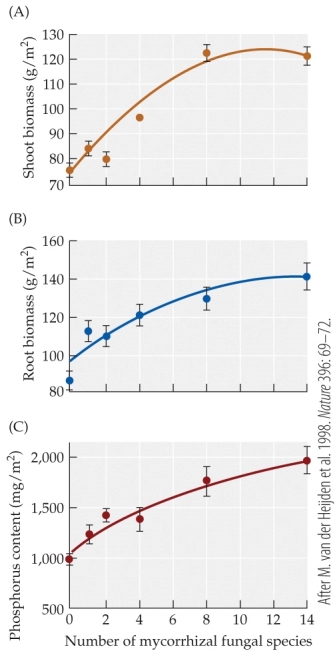Multiple Choice
Refer to the figure. In the study illustrated in the figure, van der Heijden and colleagues compared the effects of differing numbers of mycorrhizal species (0?-14) on the same 15 plant species. They measured the effects of this mycorrhizal species diversity on net primary production (measured as shoot and root biomass) and on cycling of nutrients (measured as phosphorus content) . Based on the figure, what can be concluded about the effect of mycorrhizal diversity on plant ecosystems?
In the study illustrated in the figure, van der Heijden and colleagues compared the effects of differing numbers of mycorrhizal species (0?-14) on the same 15 plant species. They measured the effects of this mycorrhizal species diversity on net primary production (measured as shoot and root biomass) and on cycling of nutrients (measured as phosphorus content) . Based on the figure, what can be concluded about the effect of mycorrhizal diversity on plant ecosystems?
A) All three factors decrease, indicating that mycorrhizal diversity inhibits plant growth.
B) All three factors increase, indicating that mycorrhizal diversity improves plant growth.
C) There appears to be little change in any of the three factors; thus, mycorrhizal diversity has little effect on plant growth.
D) Shoot biomass and phosphorus content increase, but root biomass shows little change, indicating that the presence of mycorrhizae in soil depresses root growth.
Correct Answer:

Verified
Correct Answer:
Verified
Q57: When leaf-cutter ants encounter the parasitic fungus
Q58: Which criterion is most important in determining
Q59: The interaction of fig trees and fig
Q60: Which factor in the association between figs
Q61: Most wasps are carnivores, but one group
Q63: A bacterium provides essential amino acids to
Q64: What is a "cheater" in a mutualistic
Q65: Spider crabs live on the ocean floor
Q66: What types of environmental factors can cause
Q67: Refer to the figures.<br> <img src="https://d2lvgg3v3hfg70.cloudfront.net/TBO1115/.jpg" alt="Refer